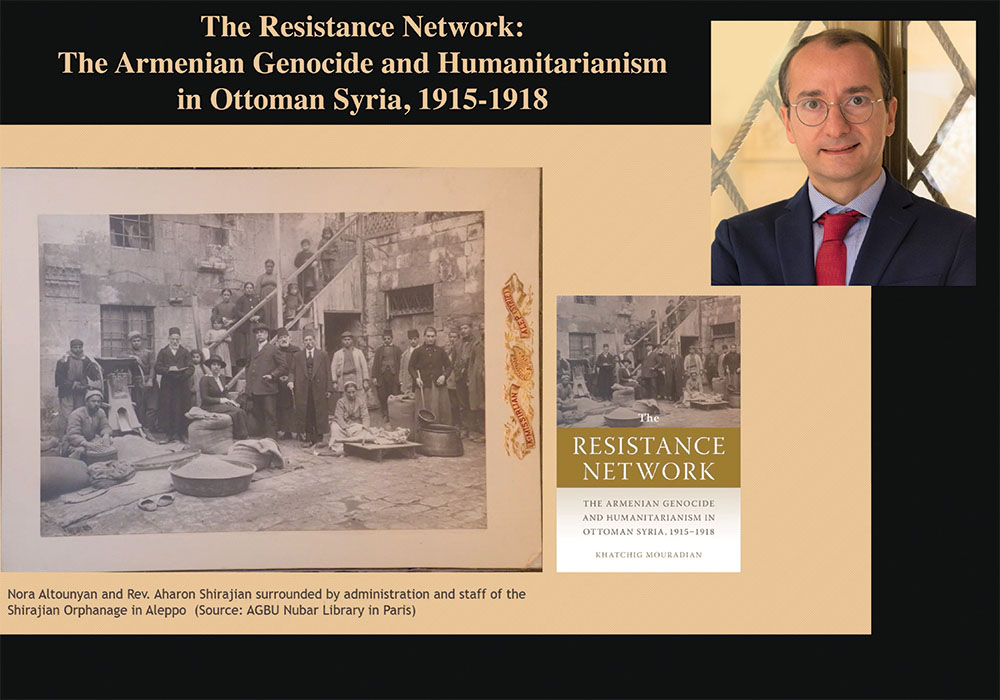
Christine Pambukyan
Staff Writer
“Often times, when we think about the Armenian Genocide, we think about destruction, death, deportations, and ultimately… a narrative of massacres. … In that kind of narrative, the role played by Armenian deportees in pushing back against the genocidal policies, in resisting these actions, is often understudied or altogether ignored,” explained Dr. Khatchig Mouradian, Armenian and Georgian Area Specialist in the African and Middle Eastern Division at the Library of Congress. His book, The Resistance Network: The Armenian Genocide and Humanitarianism in Ottoman Syria, 1915-1918, demonstrates how secret local groups of Armenians, Jews, Arabs, mission-aries, and diplomats aided Armenians during the Genocide.
On Saturday, March 27, 2021, Dr. Mouradian discussed The Resistance Network through a virtual presentation on Zoom, organized by the Armenian Studies Program at Fresno State. In his discussion, Dr. Mouradian emphasized the humanitarian aid efforts by Armenians in Ottoman Syria.
Dr. Mouradian began his lecture with an overview of his research journey. Der Zor was an important symbol of deportation for Armenians in the summer of 1916. “To this day, the discussion of the Armenian deportees who had arrived in Ottoman Syria, central as it is to the history of the genocide and omnipresent as it is in the memoirs of survivors, remains understated with the exception of a few works” stated Dr. Mouradian.
Furthermore, while conducting his research, Dr. Mouradian only found summaries and excerpts of what happened. The lack of access to primary sources and Turkish denial campaigns added to the difficulty of compiling information.
“Had it not been for the many families who shared their stories and their account with me, one of the most important parts of the history of the Armenian Genocide would have remained less known; and would have been something that is forgotten,” emphasized Dr. Mouradian.
He then stated that despite the presence of non-violent resistance, the resistance narratives of the Armenian Genocide of 1915 focus on armed resistance in places like Van, Urfa, and Musa Dagh. In those narratives, the role of women’s involvement in resisting the genocide, as well as that of other humanitarian resisters, is diminished if non-violent resistance is not mentioned.
Those who helped risked their lives, imprisonment, and torture, because their actions were against the Ottoman Empire should be included. Many who did aid the Armenians, including missionaries, Jews, and Arabs, were killed, imprisoned, or died of diseases they contracted from deportees.
Dr. Mouradian then presented a few key points he discovered in his research about Armenian humanitarian. “Armenians and others not only launched an extensive effort moments before any funds started flowing in from the United States and Europe, but also looked to themselves to supply aid to the deportees, beyond the reach of consuls and missionaries,” said Dr. Mouradian.
Dr. Mouradian mentioned a few specific examples of humanitarian resistance. “Armenians did indeed resist as soon as the Committee of Union and Progress enacted the empire-wide arrests, deportations, and massacres in the spring of 1915,” asserted Dr. Mouradian.
“What is striking is how fast some deportees who were arriving in Syria became part of this resistance network despite the risks involved, and in many cases despite their unfamiliarity with the region,” said Dr. Mouradian. In fact, from the fall of 1915 on, deportees used abandoned buildings and false documents to avoid attacks by Turkish officials. They organized schools, hospitals, hotels, orphanages that they used to house deportees. They also transported funds and prevented human trafficking. Many sacrificed their own well-being to aid the victims of genocide.
Dr. Mouradian concluded his lecture with photos of Syrian children he met in Der Zor as he and a few archeologists were looking for the Armenian remains from the Genocide of 1915. The children helped them by giving them some of those bones which they referred to as Armenie, or the Armenians. Today, the children in this photo were most likely evacuated and have become Syrian refugees.
“Their stories are the stories of today, and how we think, how we react, and how we engage with their stories and experiences will very much define the stories that people will tell one hundred years from now, when they are talking about this particular catastrophe” insists Dr. Mouradian.
A recording of the discussion, along with other lectures of this semester can be found on the Armenian Studies YouTube Channel at bit.ly/armenianstudiesyoutube.
 Hye Sharzhoom Armenian Action
Hye Sharzhoom Armenian Action